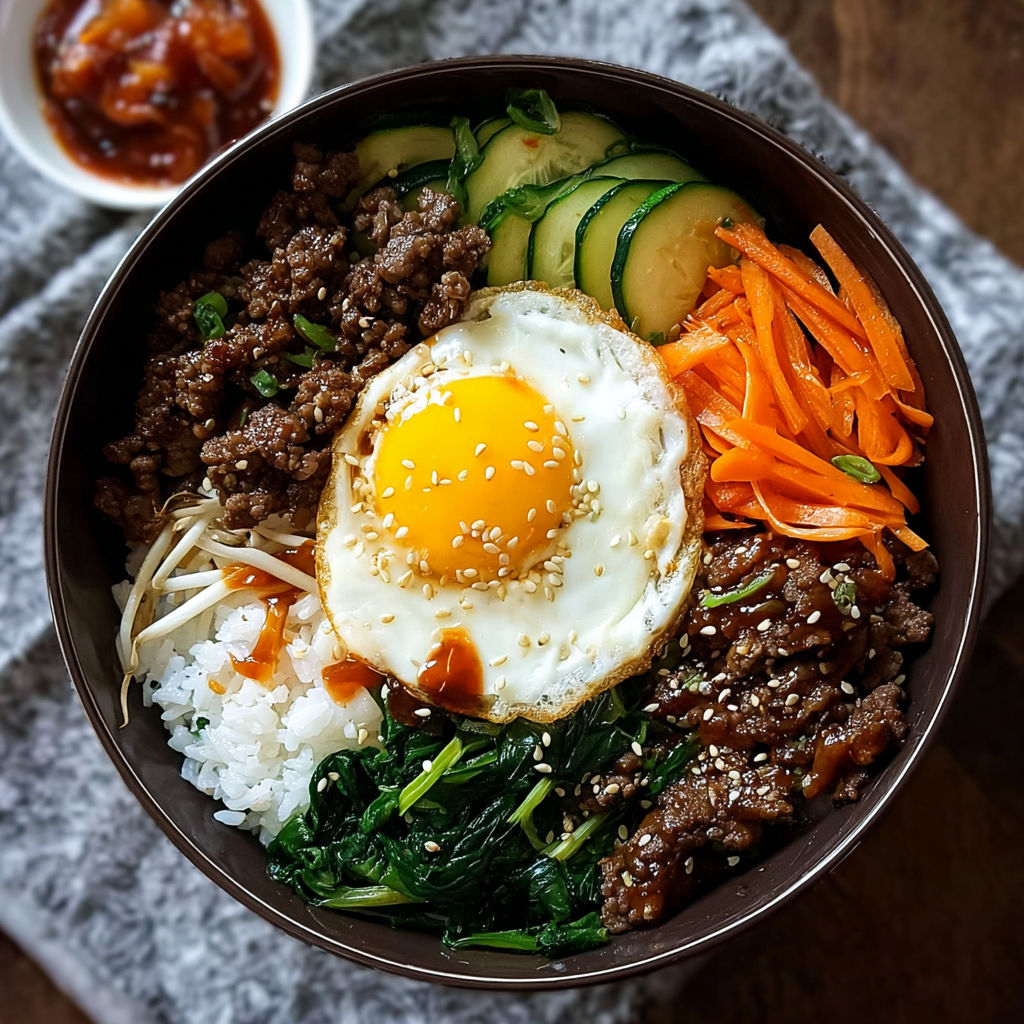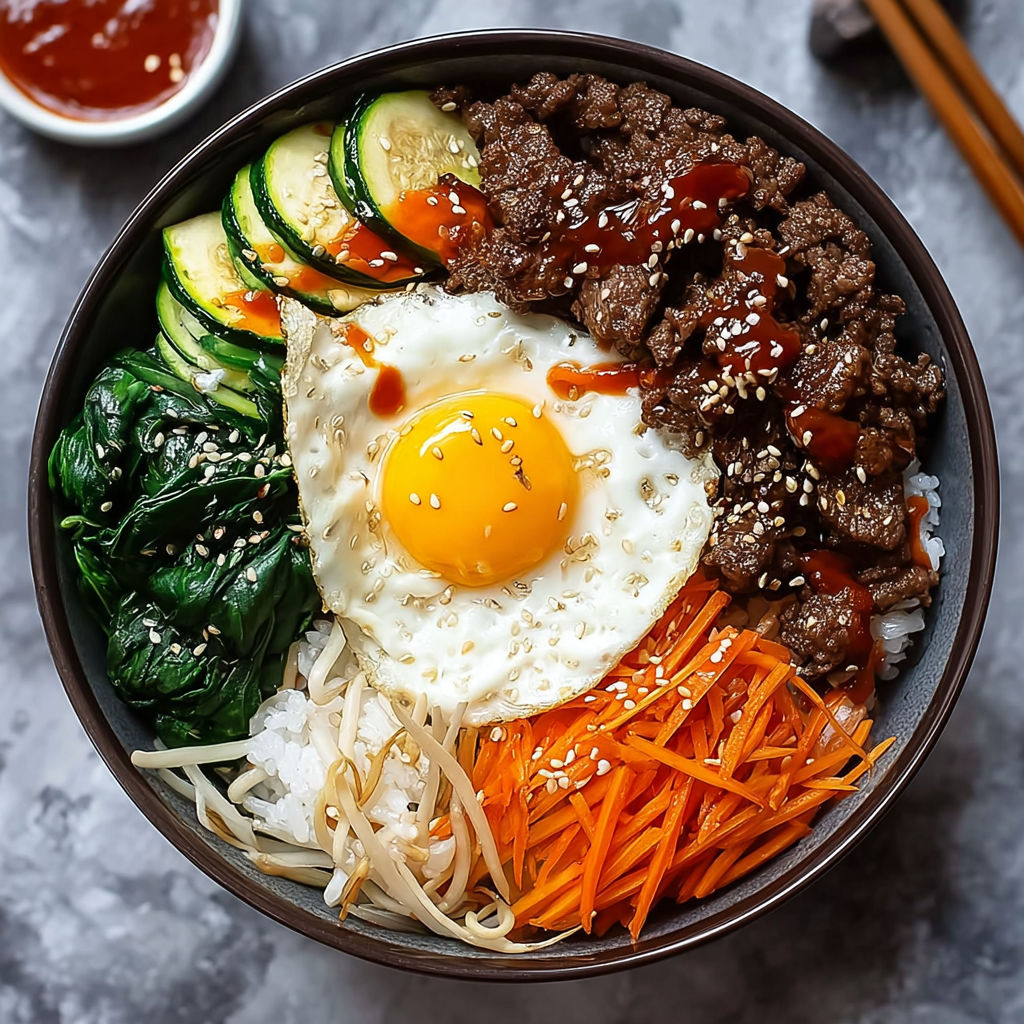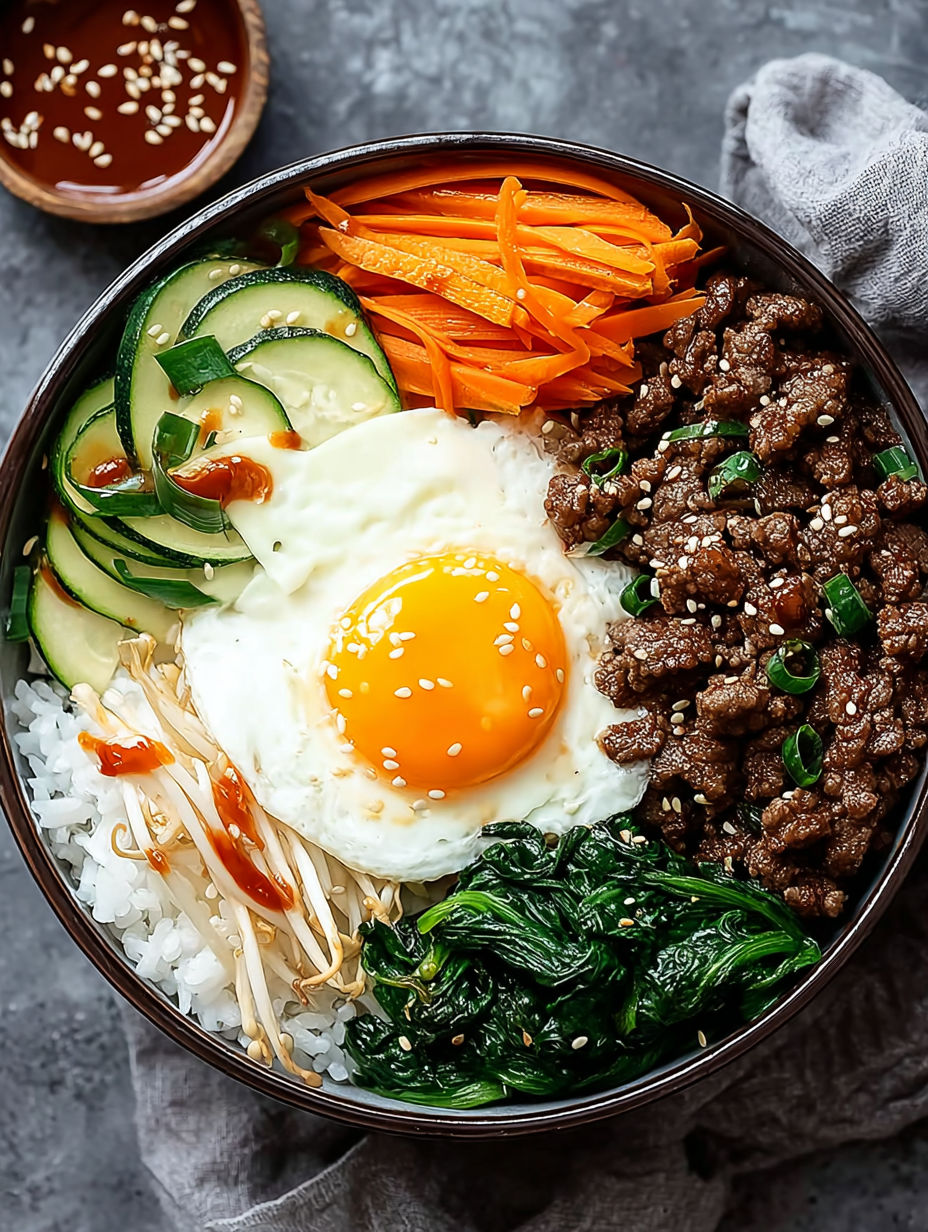 Pin
Pin
This vibrant Korean beef bibimbap bowl brings authentic Asian flavors right to your dinner table with minimal effort. The combination of seasoned ground beef, colorful vegetables, and a perfectly runny egg creates a complete meal that's as nutritious as it is delicious.
I discovered bibimbap during my first trip to Seoul and have spent years perfecting this simplified home version. My family now requests this weekly, especially my teenagers who love customizing their own bowls with extra gochujang sauce.
- Short grain rice creates the authentic sticky texture that holds up to the toppings
- Ground beef provides a budget friendly protein option that cooks quickly
- Gochujang sauce delivers the signature sweet spicy flavor that defines Korean cuisine
- Fresh vegetables add color nutrition and crunch
- Sesame oil brings that distinctive nutty aroma essential to Korean cooking
- Eggs with runny yolks create a natural sauce when mixed into the bowl
- Low sodium soy sauce adds depth without making the dish too salty
- Bean sprouts contribute a fresh crisp texture that balances the rich beef
How To Make Korean Beef Bibimbap Bowl
- Cook the rice
- Rinse short grain rice under cold water until water runs clear to remove excess starch. Cook according to package directions, then let it steam covered for 10 minutes after cooking for perfect texture. The rice should be sticky enough to hold together but not mushy.
- Brown the beef
- Heat a large skillet over medium high heat until hot. Add ground beef and break it into small crumbles with a wooden spoon. Cook for 5 to 7 minutes until no pink remains, stirring occasionally. Drain excess fat to keep the dish lighter.
- Season the meat
- Add gochujang sauce, soy sauce, and sesame oil to the cooked beef. Stir thoroughly to coat every piece of meat with the flavorful sauce. Reduce heat to low and simmer for 5 minutes, allowing the beef to absorb all those delicious flavors.
- Prepare vegetables
- Heat a tablespoon of sesame oil in a separate pan over medium heat. Add vegetables in batches, cooking each for about 2 minutes until tender crisp. Season lightly with salt. Keep each vegetable separate for the traditional presentation.
- Fry the eggs
- In a nonstick skillet, heat a small amount of oil over medium low heat. Crack eggs carefully into the pan and cook until whites are set but yolks remain runny, about 3 minutes. The runny yolk will create a creamy sauce when mixed into the bowl.
- Assemble the bowls
- Start with a base of warm rice in each bowl. Arrange beef and vegetables in separate sections around the edge of the bowl. Place the fried egg on top in the center. Serve with extra gochujang sauce on the side for diners to add according to their spice preference.
The gochujang sauce is truly the heart of this dish. I remember my Korean neighbor gifting me my first container of authentic gochujang, and it completely transformed my homemade bibimbap. That rich, sweet and spicy flavor cannot be replicated with other hot sauces, so it's worth seeking out at Asian markets or online.

Make Ahead Options
Bibimbap components can all be prepared 1 to 2 days in advance and stored separately in airtight containers. The cooked rice actually benefits from overnight refrigeration as it firms up slightly, making it perfect for reheating. Just microwave the rice with a sprinkle of water, quickly reheat the beef mixture in a skillet, and fry fresh eggs right before serving for a quick meal.
Vegetable Variations
While traditional bibimbap features specific vegetables, this recipe welcomes substitutions based on seasonal availability. Try thinly sliced bell peppers, mushrooms, cucumber, or shredded cabbage. The key is to maintain the variety of colors and textures. I often raid my refrigerator for whatever vegetables need using up, making this an excellent end of week clean out the produce drawer meal.
Serving Tradition
In authentic Korean service, bibimbap arrives at the table beautifully arranged but is then vigorously mixed together before eating. This mixing ritual is actually how the dish got its name bibimbap means mixed rice. Encourage everyone to mix their bowls thoroughly to distribute the runny egg yolk and gochujang sauce throughout all ingredients for the most flavorful experience.

Recipe FAQs
- → Can I make Korean Beef Bibimbap with other proteins?
Absolutely! While ground beef is traditional in this version, you can substitute it with thinly sliced beef bulgogi, chicken, tofu, or even mushrooms for a vegetarian option. The key is to ensure whatever protein you choose is well-seasoned with the gochujang sauce mixture.
- → What vegetables work best in bibimbap?
Traditional bibimbap typically includes carrots, spinach, bean sprouts, and zucchini as used in this dish. However, you can customize with mushrooms, cucumber, bell peppers, kimchi, or any vegetables you prefer. The important thing is to maintain a variety of colors and textures.
- → Is gochujang sauce essential for authentic bibimbap?
Yes, gochujang (Korean red pepper paste) provides the signature spicy, sweet, and savory flavor that defines bibimbap. If you're sensitive to spice, you can use less or mix it with a bit of honey to mellow the heat. In a pinch, you could substitute with sriracha mixed with a little brown sugar, though the flavor profile will be different.
- → Can bibimbap be prepared in advance?
You can prepare all the components separately up to 2 days ahead and store them in the refrigerator. When ready to serve, reheat the rice and beef, arrange the bowl with the cold or quickly reheated vegetables, and top with a freshly fried egg for the best experience.
- → What's the proper way to eat bibimbap?
Traditionally, bibimbap is served with all ingredients arranged separately in the bowl. Just before eating, you mix everything together thoroughly, allowing the runny egg yolk and sauce to coat all ingredients. This creates a perfect harmony of flavors and textures in each bite.
- → What sides pair well with bibimbap?
Bibimbap is typically a complete meal on its own, but it pairs wonderfully with traditional Korean sides like kimchi, cucumber salad, or Korean seaweed soup (miyeok-guk). A small side of pickled vegetables also complements the rich flavors of the dish.
